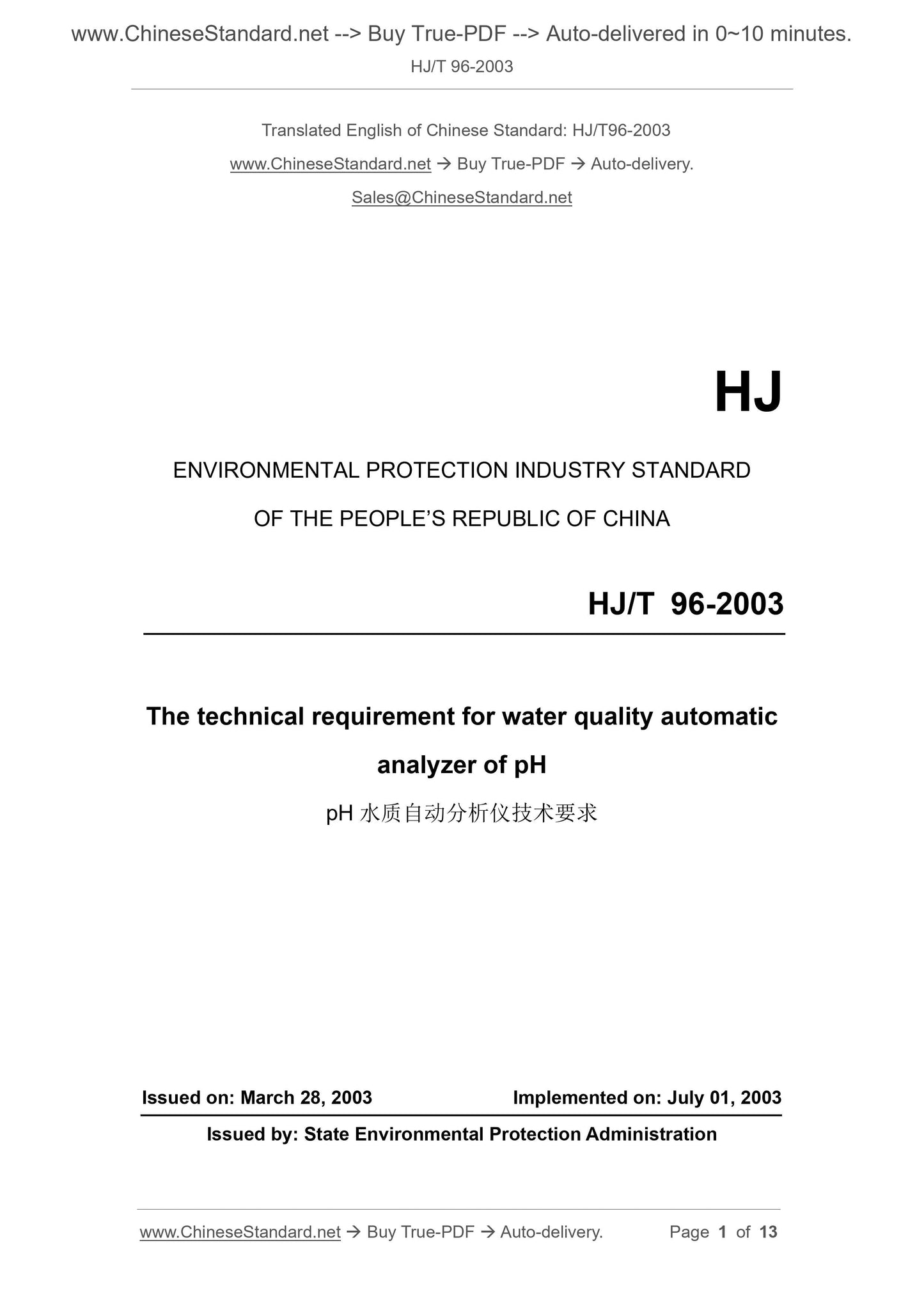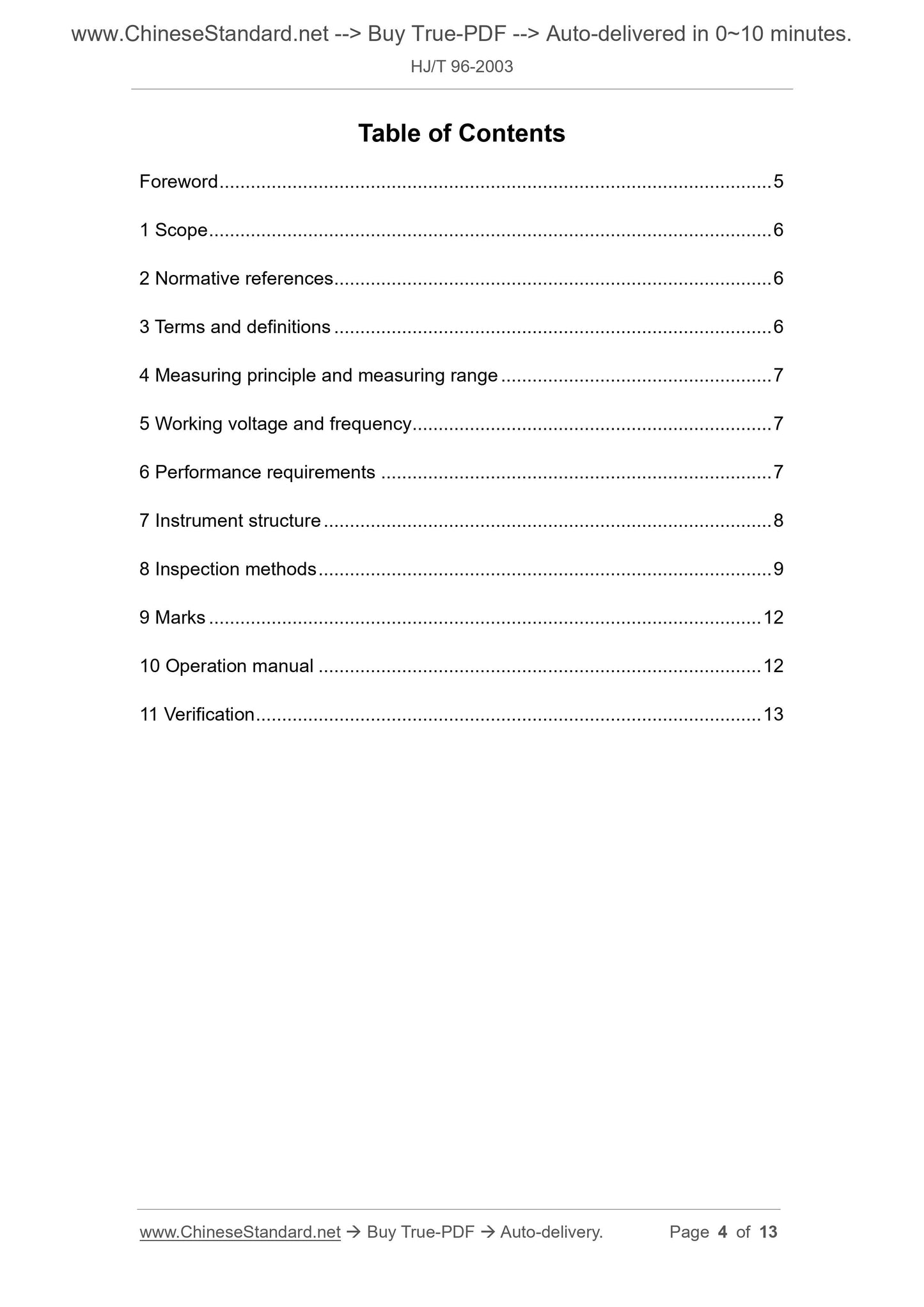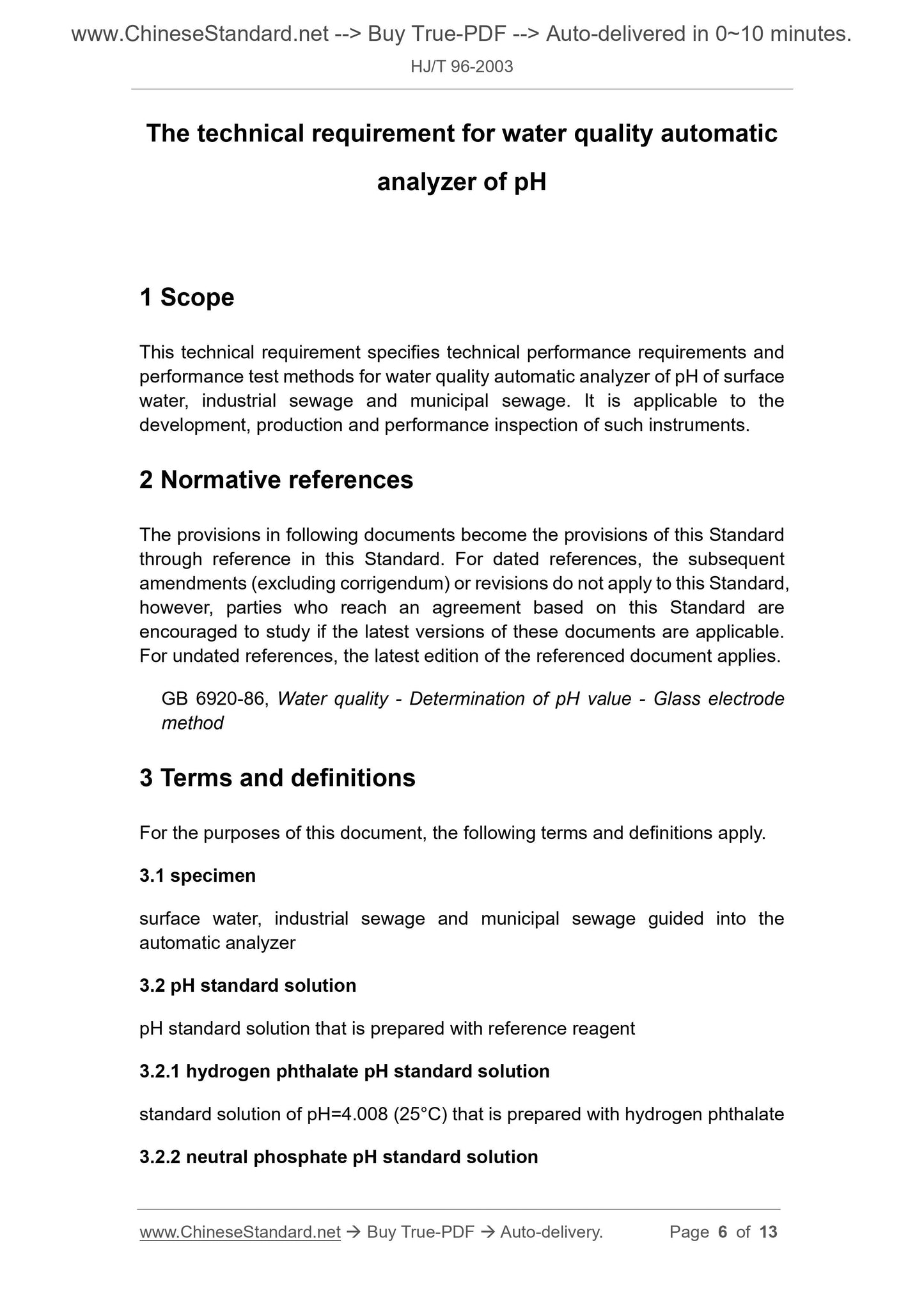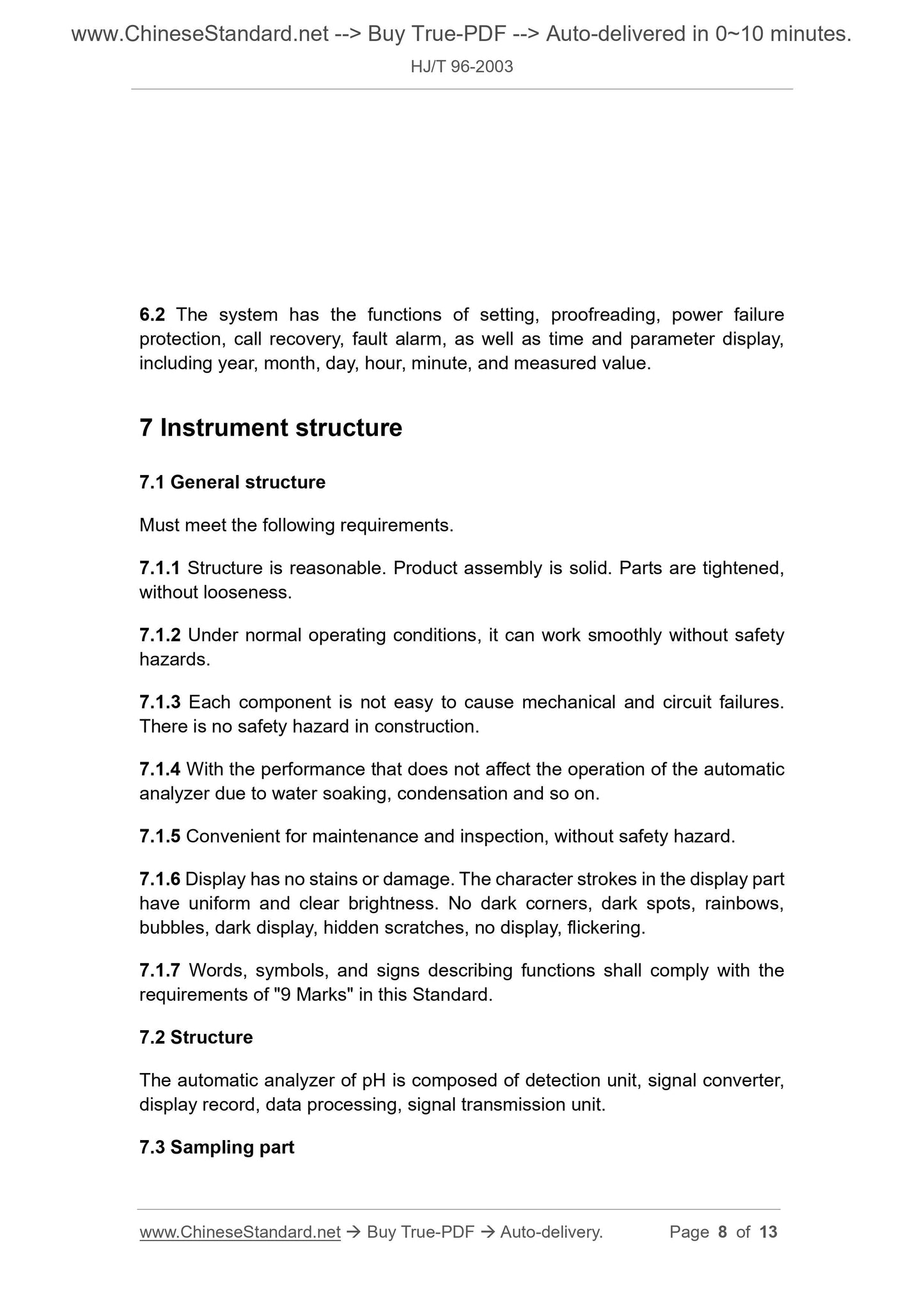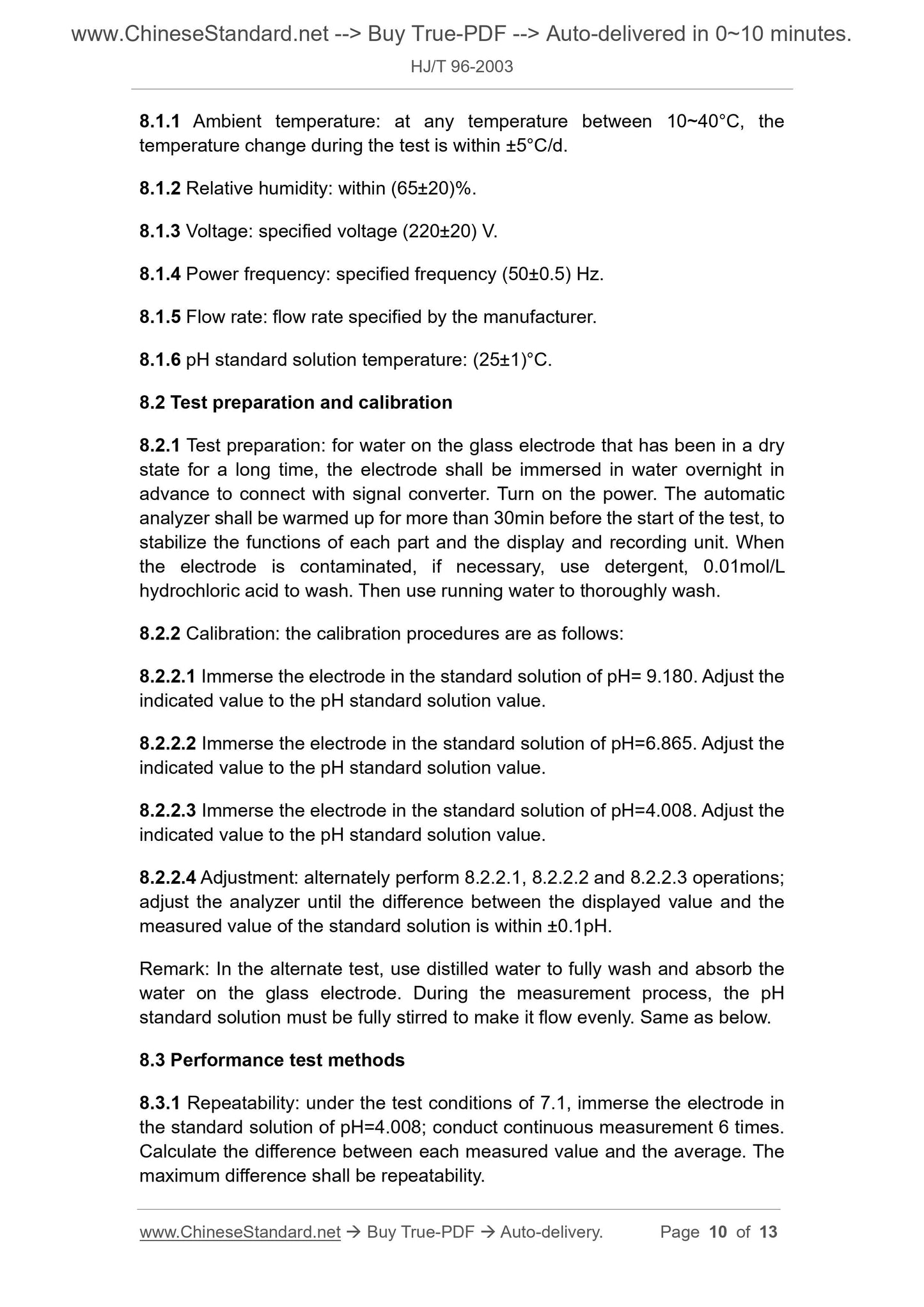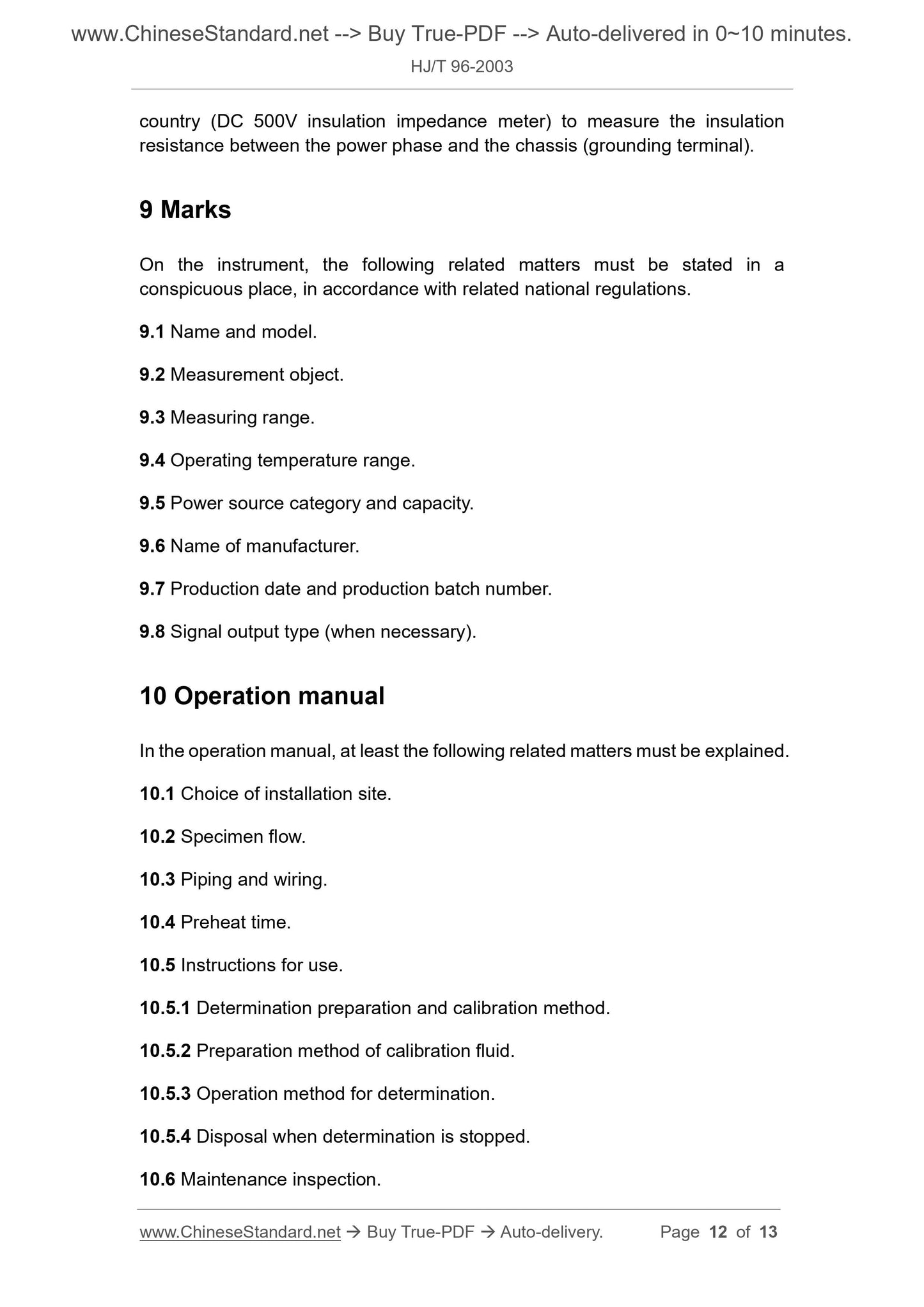1
/
of
6
PayPal, credit cards. Download editable-PDF & invoice in 1 second!
HJ/T 96-2003 English PDF (HJ/T96-2003)
HJ/T 96-2003 English PDF (HJ/T96-2003)
Regular price
$140.00 USD
Regular price
Sale price
$140.00 USD
Unit price
/
per
Shipping calculated at checkout.
Couldn't load pickup availability
Delivery: 3 seconds. Download true-PDF + Invoice.
Get QUOTATION in 1-minute: Click HJ/T 96-2003
Historical versions: HJ/T 96-2003
Preview True-PDF (Reload/Scroll if blank)
HJ/T 96-2003: The technical requirement for water quality automatic analyzer of PH
HJ/T 96-2003
HJ
ENVIRONMENTAL PROTECTION INDUSTRY STANDARD
OF THE PEOPLE’S REPUBLIC OF CHINA
The technical requirement for water quality automatic
analyzer of pH
ISSUED ON: MARCH 28, 2003
IMPLEMENTED ON: JULY 01, 2003
Issued by: State Environmental Protection Administration
Table of Contents
Foreword ... 5
1 Scope ... 6
2 Normative references ... 6
3 Terms and definitions ... 6
4 Measuring principle and measuring range ... 7
5 Working voltage and frequency ... 7
6 Performance requirements ... 7
7 Instrument structure ... 8
8 Inspection methods ... 9
9 Marks ... 12
10 Operation manual ... 12
11 Verification ... 13
The technical requirement for water quality automatic
analyzer of pH
1 Scope
This technical requirement specifies technical performance requirements and
performance test methods for water quality automatic analyzer of pH of surface
water, industrial sewage and municipal sewage. It is applicable to the
development, production and performance inspection of such instruments.
2 Normative references
The provisions in following documents become the provisions of this Standard
through reference in this Standard. For dated references, the subsequent
amendments (excluding corrigendum) or revisions do not apply to this Standard,
however, parties who reach an agreement based on this Standard are
encouraged to study if the latest versions of these documents are applicable.
For undated references, the latest edition of the referenced document applies.
GB 6920-86, Water quality - Determination of pH value - Glass electrode
method
3 Terms and definitions
For the purposes of this document, the following terms and definitions apply.
3.1 specimen
surface water, industrial sewage and municipal sewage guided into the
automatic analyzer
3.2 pH standard solution
pH standard solution that is prepared with reference reagent
3.2.1 hydrogen phthalate pH standard solution
standard solution of pH=4.008 (25°C) that is prepared with hydrogen phthalate
3.2.2 neutral phosphate pH standard solution
6.2 The system has the functions of setting, proofreading, power failure
protection, call recovery, fault alarm, as well as time and parameter display,
including year, month, day, hour, minute, and measured value.
7 Instrument structure
7.1 General structure
Must meet the following requirements.
7.1.1 Structure is reasonable. Product assembly is solid. Parts are tightened,
without looseness.
7.1.2 Under normal operating conditions, it can work smoothly without safety
hazards.
7.1.3 Each component is not easy to cause mechanical and circuit failures.
There is no safety hazard in construction.
7.1.4 With the performance that does not affect the operation of the automatic
analyzer due to water soaking, condensation and so on.
7.1.5 Convenient for maintenance and inspection, without safety hazard.
7.1.6 Display has no stains or damage. The character strokes in the display part
have uniform and clear brightness. No dark corners, dark spots, rainbows,
bubbles, dark display, hidden scratches, no display, flickering.
7.1.7 Words, symbols, and signs describing functions shall comply with the
requirements of "9 Marks" in this Standard.
7.2 Structure
The automatic analyzer of pH is composed of detection unit, signal converter,
display record, data processing, signal transmission unit.
7.3 Sampling part
8.1.1 Ambient temperature: at any temperature between 10~40°C, the
temperature change during the test is within ±5°C/d.
8.1.2 Relative humidity: within (65±20)%.
8.1.3 Voltage: specified voltage (220±20) V.
8.1.4 Power frequency: specified frequency (50±0.5) Hz.
8.1.5 Flow rate: flow rate specified by the manufacturer.
8.1.6 pH standard solution temperature: (25±1)°C.
8.2 Test preparation and calibration
8.2.1 Test preparation: for water on the glass electrode that has been in a dry
state for a long time, the electrode shall be immersed in water overnight in
advance to connect with signal converter. Turn on the power. The automatic
analyzer shall be warmed up for more than 30min before the start of the test, to
stabilize the functions of each part and the display and recording unit. When
the electrode is contaminated, if necessary, use detergent, 0.01mol/L
hydrochloric acid to wash. Then use running water to thoroughly wash.
8.2.2 Calibration: the calibration procedures are as follows:
8.2.2.1 Immerse the electrode in the standard solution of pH= 9.180. Adjust the
indicated value to the pH standard solution value.
8.2.2.2 Immerse the electrode in the standard solution of pH=6.865. Adjust the
indicated value to the pH standard solution value.
8.2.2.3 Immerse the electrode in the standard solution of pH=4.008. Adjust the
indicated value to the pH standard solution value.
8.2.2.4 Adjustment: alternately perform 8.2.2.1, 8.2.2.2 and 8.2.2.3 operations;
adjust the analyzer until the difference between the displayed value and the
measured value of the standard solution is within ±0.1pH.
Remark: In the alternate test, use distilled water to fully wash and absorb the
water on the glass electrode. During the measurement process, the pH
standard solution must be fully stirred to make it flow evenly. Same as below.
8.3 Performance test methods
8.3.1 Repeatability: under the test conditions of 7.1, immerse the electrode in
the standard solution of pH=4.008; conduct continuous measurement 6 times.
Calculate the difference between each measured value and the average. The
maximum difference shall be repeatability.
country (DC 500V insulation impedance meter) to measure the insulation
resistance between the power phase and the chassis (grounding terminal).
9 Marks
On the instrument, the following related matters must be stated in a
conspicuous place, in accordance with related national regulations.
9.1 Name and model.
9.2 Measurement object.
9.3 Measuring range.
9.4 Operating temperature range.
9.5 Power source category and capacity.
9.6 Name of manufacturer.
9.7 Production date and production batch number.
9.8 Signal output type (when necessary).
10 Operation manual
In the operation manual, at least the following related matters must be explained.
10.1 Choice of installation site.
10.2 Specimen flow.
10.3 Piping and wiring.
10.4 Preheat time.
10.5 Instructions for use.
10.5.1 Determination preparation and calibration method.
10.5.2 Preparation method of calibration fluid.
10.5.3 Operation method for determination.
10.5.4 Disposal when determination is stopped.
10.6 Maintenance inspection.
Get QUOTATION in 1-minute: Click HJ/T 96-2003
Historical versions: HJ/T 96-2003
Preview True-PDF (Reload/Scroll if blank)
HJ/T 96-2003: The technical requirement for water quality automatic analyzer of PH
HJ/T 96-2003
HJ
ENVIRONMENTAL PROTECTION INDUSTRY STANDARD
OF THE PEOPLE’S REPUBLIC OF CHINA
The technical requirement for water quality automatic
analyzer of pH
ISSUED ON: MARCH 28, 2003
IMPLEMENTED ON: JULY 01, 2003
Issued by: State Environmental Protection Administration
Table of Contents
Foreword ... 5
1 Scope ... 6
2 Normative references ... 6
3 Terms and definitions ... 6
4 Measuring principle and measuring range ... 7
5 Working voltage and frequency ... 7
6 Performance requirements ... 7
7 Instrument structure ... 8
8 Inspection methods ... 9
9 Marks ... 12
10 Operation manual ... 12
11 Verification ... 13
The technical requirement for water quality automatic
analyzer of pH
1 Scope
This technical requirement specifies technical performance requirements and
performance test methods for water quality automatic analyzer of pH of surface
water, industrial sewage and municipal sewage. It is applicable to the
development, production and performance inspection of such instruments.
2 Normative references
The provisions in following documents become the provisions of this Standard
through reference in this Standard. For dated references, the subsequent
amendments (excluding corrigendum) or revisions do not apply to this Standard,
however, parties who reach an agreement based on this Standard are
encouraged to study if the latest versions of these documents are applicable.
For undated references, the latest edition of the referenced document applies.
GB 6920-86, Water quality - Determination of pH value - Glass electrode
method
3 Terms and definitions
For the purposes of this document, the following terms and definitions apply.
3.1 specimen
surface water, industrial sewage and municipal sewage guided into the
automatic analyzer
3.2 pH standard solution
pH standard solution that is prepared with reference reagent
3.2.1 hydrogen phthalate pH standard solution
standard solution of pH=4.008 (25°C) that is prepared with hydrogen phthalate
3.2.2 neutral phosphate pH standard solution
6.2 The system has the functions of setting, proofreading, power failure
protection, call recovery, fault alarm, as well as time and parameter display,
including year, month, day, hour, minute, and measured value.
7 Instrument structure
7.1 General structure
Must meet the following requirements.
7.1.1 Structure is reasonable. Product assembly is solid. Parts are tightened,
without looseness.
7.1.2 Under normal operating conditions, it can work smoothly without safety
hazards.
7.1.3 Each component is not easy to cause mechanical and circuit failures.
There is no safety hazard in construction.
7.1.4 With the performance that does not affect the operation of the automatic
analyzer due to water soaking, condensation and so on.
7.1.5 Convenient for maintenance and inspection, without safety hazard.
7.1.6 Display has no stains or damage. The character strokes in the display part
have uniform and clear brightness. No dark corners, dark spots, rainbows,
bubbles, dark display, hidden scratches, no display, flickering.
7.1.7 Words, symbols, and signs describing functions shall comply with the
requirements of "9 Marks" in this Standard.
7.2 Structure
The automatic analyzer of pH is composed of detection unit, signal converter,
display record, data processing, signal transmission unit.
7.3 Sampling part
8.1.1 Ambient temperature: at any temperature between 10~40°C, the
temperature change during the test is within ±5°C/d.
8.1.2 Relative humidity: within (65±20)%.
8.1.3 Voltage: specified voltage (220±20) V.
8.1.4 Power frequency: specified frequency (50±0.5) Hz.
8.1.5 Flow rate: flow rate specified by the manufacturer.
8.1.6 pH standard solution temperature: (25±1)°C.
8.2 Test preparation and calibration
8.2.1 Test preparation: for water on the glass electrode that has been in a dry
state for a long time, the electrode shall be immersed in water overnight in
advance to connect with signal converter. Turn on the power. The automatic
analyzer shall be warmed up for more than 30min before the start of the test, to
stabilize the functions of each part and the display and recording unit. When
the electrode is contaminated, if necessary, use detergent, 0.01mol/L
hydrochloric acid to wash. Then use running water to thoroughly wash.
8.2.2 Calibration: the calibration procedures are as follows:
8.2.2.1 Immerse the electrode in the standard solution of pH= 9.180. Adjust the
indicated value to the pH standard solution value.
8.2.2.2 Immerse the electrode in the standard solution of pH=6.865. Adjust the
indicated value to the pH standard solution value.
8.2.2.3 Immerse the electrode in the standard solution of pH=4.008. Adjust the
indicated value to the pH standard solution value.
8.2.2.4 Adjustment: alternately perform 8.2.2.1, 8.2.2.2 and 8.2.2.3 operations;
adjust the analyzer until the difference between the displayed value and the
measured value of the standard solution is within ±0.1pH.
Remark: In the alternate test, use distilled water to fully wash and absorb the
water on the glass electrode. During the measurement process, the pH
standard solution must be fully stirred to make it flow evenly. Same as below.
8.3 Performance test methods
8.3.1 Repeatability: under the test conditions of 7.1, immerse the electrode in
the standard solution of pH=4.008; conduct continuous measurement 6 times.
Calculate the difference between each measured value and the average. The
maximum difference shall be repeatability.
country (DC 500V insulation impedance meter) to measure the insulation
resistance between the power phase and the chassis (grounding terminal).
9 Marks
On the instrument, the following related matters must be stated in a
conspicuous place, in accordance with related national regulations.
9.1 Name and model.
9.2 Measurement object.
9.3 Measuring range.
9.4 Operating temperature range.
9.5 Power source category and capacity.
9.6 Name of manufacturer.
9.7 Production date and production batch number.
9.8 Signal output type (when necessary).
10 Operation manual
In the operation manual, at least the following related matters must be explained.
10.1 Choice of installation site.
10.2 Specimen flow.
10.3 Piping and wiring.
10.4 Preheat time.
10.5 Instructions for use.
10.5.1 Determination preparation and calibration method.
10.5.2 Preparation method of calibration fluid.
10.5.3 Operation method for determination.
10.5.4 Disposal when determination is stopped.
10.6 Maintenance inspection.
Share
